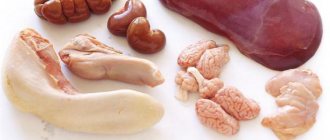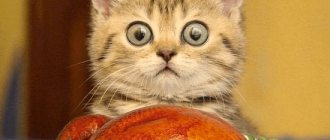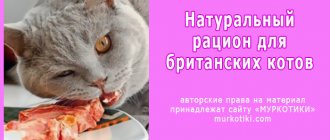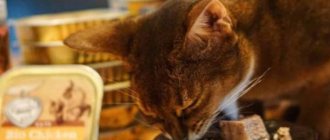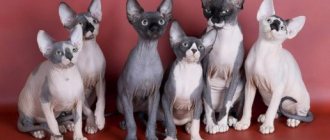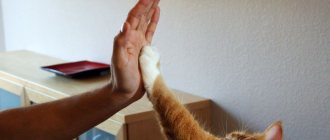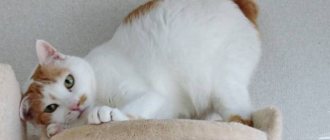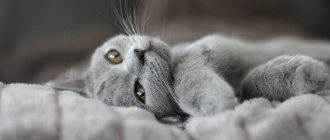Feeding cats with natural food is as close as possible to the conditions of the wild. Despite this, such a diet has its disadvantages and nuances. Before feeding your animal regular foods, be sure to familiarize yourself with possible problems and features. This will help you weigh the pros and cons between dry food and natural food.
Why owners choose natural feeding
Most owners refuse dry food, choosing a more natural way of feeding. Citing the advantages of a “straight woman” as an example, they often forget about her shortcomings.
Advantages
The main advantage is the ability to independently control the quality of ingredients. This eliminates the presence of harmful chemicals and artificial components.
With this type of nutrition, it is easier to choose an individual diet, based on the characteristics and preferences of your pet. It is much easier to accustom to “natural” than to “drying”. Cats are carnivores, so they happily eat meat and offal.
Possible disadvantages
Natural food for cats should always be fresh, which means it will have to be prepared every day. This takes a lot of time and effort, so not all owners are ready for such sacrifices.
In addition to the laboriousness of preparation, it is worth noting the difficulty of achieving a balance of KBJU (calories, proteins, fats and carbohydrates) and the mandatory inclusion of vitamin and mineral supplements. There is also a high probability of helminth infection or poisoning associated with improper storage or preparation of products.
How to switch an animal to natural food
It’s good when a kitten is accustomed to natural products from childhood, but it is quite possible to retrain a cat that is accustomed to dry food. If you change food suddenly, the animal may become stubborn, refuse to eat and go hungry for several days. To make the transition painless, you will have to try a little.
Natural food should be mixed in a small amount into the daily portion of dry food, replacing approximately 10% at first. Gradually, the share of natural food should be increased, and dry food should be reduced. After two weeks, you can completely switch to natural nutrition.
Main components of the diet
A natural diet for cats consists of proteins, fats and carbohydrates. Their percentage ratio should ideally be 52:36:12.
Proteins: meat and dairy products
Proteins are used in the construction of new cells and act as the main source of energy. All of them are divided into 2 large groups:
- Animals
. Contained in meat (chicken, turkey, beef, rabbit, lamb), offal (liver, lung, heart), fish, eggs and fermented milk products (cottage cheese, kefir, yogurt). Chicken protein is the easiest to digest, and the worst is beef and lamb protein. Such proteins contain many amino acids and taurine, an essential element responsible for cell protection and regeneration.
- Vegetable
. Contained in soybean meal, corn gluten and wheat. They are less digestible than animal proteins and put a strain on the kidneys, which leads to alkalinization of the urine. Can be used in small quantities as a temporary alternative to more expensive animal proteins.
When feeding, it is necessary to use well-frozen raw and boiled meat or sea fish, cleaned of bones. Fish can be given no more than 1-2 times a week, since the thiaminase it contains destroys vitamin B. Eggs should be given according to the same scheme.
Fermented milk products cannot serve as the main dish, so they are used as an additive.
Where are fats found?
Fats are responsible for energy “in reserve.” They are also responsible for the absorption of fat-soluble vitamins and the synthesis of certain hormones. The most beneficial fatty acid is Omega-6, found in fish. This element can also be obtained from corn, pumpkin or flaxseed.
Remember to maintain balance. A lack of fat can affect the quality of skin and coat, and an excess can lead to pancreatitis and intestinal upset.
Carbohydrates: cereals and vegetables
Carbohydrates make up the smallest portion of a cat's natural diet, as they take much more time and effort to digest. In the wild, these elements enter the cat's stomach in a semi-digested form through a captured rodent.
Despite this, a small amount of carbohydrates is simply necessary for mustachioed pets. Of these, the following elements enter the body:
- fiber, which normalizes stool and facilitates hair removal;
- adhesive substance that prevents constipation;
- glucose, which supports the functioning of the kidneys, brain and other vital organs;
- prebiotics that normalize intestinal microflora and facilitate the absorption of food.
Carbohydrates come from raw, boiled or steamed vegetables (broccoli, zucchini, pumpkin) and fruits (apples). Complex carbohydrates include oatmeal, buckwheat, rice and egg.
Vitamins and microelements
Unlike “drying”, “natural” for cats should be supplemented with vitamin and mineral complexes. The most important elements include:
- manganese;
- iodine;
- calcium;
- potassium;
- iron;
- taurine;
- phosphorus;
- potassium;
- omega 3 and 6;
- B vitamins and ascorbic acid.
It is better to discuss the choice of drug with your veterinarian, since the dosage is calculated individually. Additionally, you can add sprouted oats and brewer's yeast to your food.
A lack of vitamins is accompanied by deterioration in coat quality, loss of body weight, loss of activity and frequent colds. Excess is no less dangerous, so never buy drugs on the advice of friends.
Expert recommendations for choosing a nutritious diet
Veterinarians are also positive about formulating a diet for cats based on natural products. Currently, the BARF (Biologically Appropriate Raw Food) system is widely used in Europe and America. It was invented in the nineties of the last century by veterinarian Ian Billinghurst from Australia. However, feeding only raw foods is associated with certain risks for the health of cats, so our doctors adhere to the need for heat treatment.
Video: veterinarian talks about the correct natural diet of an animal
What components must be present in a cat's diet?
A balanced diet includes proteins, fats, carbohydrates and vitamin-mineral complexes. Their quantity and daily calorie intake are determined based on data on the cat’s age and weight: for this purpose, it is recommended to use reference tables.
Based on these data, you can calculate the amount of necessary components in the diet.
What foods should be included in a cat’s diet:
- Meat, poultry and meat products are the main source of protein and essential amino acids. They should be served raw (exclusively after freezing), boiled or stewed. It is recommended to use lean beef, lamb, rabbit, chicken and turkey to feed your cat. Lamb, pork, duck and quail are too heavy for the animal's stomach, as they contain a lot of fat. Among meat products, preference should be given to ventricles, hearts and liver.
- Fish contains lipids, amino acids, phosphorus and magnesium. It is recommended to use sea fish to feed cats: unlike freshwater fish, it does not accumulate toxic substances in its composition. Fish should be given boiled, after removing the head, fins, tail, scales and all bones: these components are not digested in the stomach. The most useful fish include: pink salmon, hake, salmon, trout, taimen.
- Butter and vegetable oil are essential sources of fats and vitamin E, help strengthen vascular walls and increase resistance to infections. A lack of fat in an animal's diet can lead to reproductive dysfunction. Oil should be added to food in an amount of no more than half a teaspoon.
- Dairy products and eggs. Dairy products are rich in calcium and protein and are easily digestible by your pet's body. These include kefir, fermented baked milk, natural yoghurts without additives, cottage cheese, sour cream. Mostly the yolk is used from eggs for cat diet: it contains the required amount of fat.
- Porridges and cereals act as a source of slowly digestible carbohydrates. To feed your furry pets you should use buckwheat, oatmeal or rolled oats, millet, rice, boiled in water. It is better to avoid semolina porridge: it has no nutritional value and contains only empty carbohydrates.
- Vegetables are not only a source of healthy vitamins, but also fill the need for fiber. It improves the functioning of the gastrointestinal tract and stimulates digestion processes. Vegetables need to be boiled, baked or ground into a paste using a blender. Most often, cats' menu includes pumpkin, zucchini, broccoli, carrots, and beets. Cabbage, potatoes, legumes and peas cause excessive gas formation, so they are not used. You can use spinach, green onions, celery, and basil as healthy additives.
Cats can often develop interesting taste preferences. The cat of my grandmother, who lived in the village, loved raw cucumbers very much and regularly stole them from the garden. The fluffy pet could handle a whole cucumber alone and never refused a supplement. My sister's cat really loves bananas and melons, but since they contain a lot of sugar, the animal manages to enjoy them only occasionally.
Photo gallery: healthy food for pets
Meat should be served cut into small cubes
Dairy products are rich in calcium
Cereals satisfy the need for slow carbohydrates
Vegetables are the best source of fiber and vitamins
What foods should you avoid altogether?
Some foods and additives familiar to humans are strictly prohibited from being used in the diet of cats. The body of furry pets is much more sensitive to various food components. An incorrectly formulated diet can lead to the development of serious diseases of the liver, stomach, bones and joints, or even cause premature death.
What should not be added to a cat's diet:
- Ketchup, mayonnaise, adjika and any other sauces. They contain a lot of spices and can also be very salty and spicy. If you think that the dish prepared for your pet is dry, it is better to dilute it with sour cream or meat broth.
- Meat trimmings, chicken skin, chicken bones. These leftovers do not provide any nutritional value, but can become ballast for your pet's digestive system. Sharp edges of bones and their fragments can injure a cat's delicate gastrointestinal tract.
- Sausage, frankfurters, sausages, stewed meat, meat pates. These products are more adapted to the human diet: they contain many third-party additives and soy, but they cannot replace real meat.
- Sweet yoghurts, snowballs, condensed milk, ice cream. Despite the fact that these products also belong to the dairy category, they contain too much sugar. It has been proven that even minor consumption of condensed milk creates a risk of damage to the pancreas and the development of diabetes in cats.
- Floury. Bread, any pastries and cookies are poorly absorbed in the body of a furry pet and provoke constipation.
- Tea. Many owners are touched when their cat drinks the rest of the tea from their mug. However, tea (especially black tea) contains caffeine, which has a stimulating effect on the animal’s nervous system and leads to the development of restless behavior and hyperactivity.
While studying at the university, in one of the classes on clinical laboratory diagnostics, we studied the composition and properties of urine using the example of cat urine. One of my classmates collected urine from her cat and brought this sample to class for research. Our teacher conducted several tests with special strips that detect the presence of glucose in urine: they turned out to be positive. It turned out that the day before, a classmate fed her cat sweet yogurt: this caused a sharp jump in sugar levels in the animal’s body. The teacher recommended reconsidering the furry pet’s diet and giving up such food forever.
Photo gallery: prohibited products for animals
Sausages contain a lot of soy and third-party additives
Flour slows down your cat's digestion
Mayonnaise contains a lot of fat
What foods should not be given to a cat?
Before feeding your cat natural food, read the list of prohibited foods. These include:
- millet, pearl barley, semolina and corn cereals;
- river fish and any bones;
- potatoes and mushrooms;
- legumes and white cabbage;
- onions, sorrel and garlic;
- pork and lard;
- grapes and raisins.
Milk is only beneficial for kittens, since the body of adult animals does not digest lactose. It is also worth excluding any handouts from the table: flour, spices, pickles, smoked foods, sweets, fatty and fried foods.
Calculation of the daily portion of natural drinks
On average, the daily portion for an adult cat is 5% of body weight. For simplicity, you can limit yourself to this indicator, but it is more reliable to take into account the characteristics of your pet and calculate not the number of grams, but the total calorie content.
For this purpose, it is recommended to use the following formula:
K*(30*m + 70), where K is the multiplier coefficient, and m is the weight of the animal.
The coefficient values can be found in the table below.
| Physiological features | K |
| Lactation period | 2-4 |
| Pregnancy | 1,6-2 |
| Adult and active animal | 1,6 |
| Adult animal with low activity | 1,4 |
| Kitten or adult animal with low weight | 1,2-1,4 |
| Presence of castration or sterilization | 1,2 |
| Elderly age | 1,1 |
| Frequent overeating, fraught with rapid obesity | 1 |
| Physician-confirmed obesity | 0,8 |
If your cat is carrying kittens and weighs 4.5 kg, then she will need 328-410 kcal per day. To get the serving size, the indicated number of calories must be divided by 2, since adults eat twice a day.
Important Rules
Feeding your cat natural products should be safe. Be careful when purchasing meat to avoid the presence of hormones and parasites.
Maintain regular feedings. This will help wean you off begging and eliminate prolonged feelings of hunger. Kittens up to 3 months are fed at least 6 times a day, gradually reducing the frequency to 2 times a day by 1 year.
Serve food in the same area and be sure to use different bowls if you have multiple pets. This will eliminate fights with subsequent overeating in the strongest pet. Remember that food should be at room temperature, and leftovers should be thrown away or refrigerated for several hours.
Natural homemade food recipes for furry pets
Dishes for your cat can be not only healthy, but also varied. You can prepare your pet’s main meal, desserts and various pleasant treats yourself.
Many dishes prepared in this way can be poured into containers or placed in special bags and frozen. This way you will save yourself from lengthy cooking and provide your cat with a supply of food for a long time.
Recipes for preparing healthy dishes:
- Nutritious pate. Boil 0.5 kg of any meat for half an hour, then remove from the pan and add carrots and broccoli to the resulting broth. They must be cooked until half cooked. Pour boiling water over one glass of rolled oats and leave for 15 minutes, then pour out the water. Mix the meat with vegetables and oatmeal in a blender until it becomes a soft paste, add broth if necessary.
- Chicken gizzards with buckwheat. Pour half a glass of buckwheat porridge with water for a day. Boil chicken gizzards and one large carrot, then grind them in a meat grinder or using a blender. Add a small piece of butter to the porridge, pour in the gizzard and carrot pate.
- Millet porridge with turkey and vegetables. Boil small beets and carrots, peel and finely chop the raw zucchini. Divide the turkey into small pieces and cook millet porridge. Grind the vegetables together with the meat in a meat grinder, then add to the porridge. If necessary, you can dilute the dish by adding egg yolk.
- Lamb fillet with rice porridge. Grate freshly frozen lamb meat along with raw carrots. Boil the broccoli and rice in advance, then mix all the ingredients in a bowl with a small amount of olive oil.
- Beef with vegetable stew. Cut the boiled beef into small pieces, mix with baked pumpkin, stewed carrots and zucchini, pour in meat broth.
My cat really loves stewed liver: this dish ranks almost first among her taste preferences. The recipe is quite simple. Cut the liver into small pieces, grate the carrots, chop the green onions. Pour some water into a small frying pan, add all the ingredients and simmer for 20-25 minutes. It turns out to be a quite tasty and nutritious dish that can be mixed with any porridge.
How to prepare a healthy and tasty treat for your furry baby:
- Beef patties. On a fine grater, grate frozen beef (about 200 g), one large carrot, 3 lettuce leaves and 30 g of celery. Add 2-5 drops of olive oil and stir, then beat one egg into the mixture. Yandex Form thin flat cakes, place them on baking paper and bake at a temperature of about 140 degrees until they become golden brown.
- Curd balls. Take thick cottage cheese with 1-2% fat content, mix it with a few tablespoons of sour cream. Form small balls and place them in the refrigerator for a couple of hours to set.
- Chicken with cheese. Peel the skin from the chicken breast, then cut into small pieces. Place it in the oven at 150 degrees, grating no more than 1 tablespoon of hard, lightly salted cheese on top.
Approximate diet for 4 days
Before going to the store, think through your diet for the week ahead, based on the permitted products. For an example, check out the menu for an adult pet for 4 days.
| Day | 1st meal | 2nd meal |
| First | Cottage cheese with raw quail egg | Boiled cod with vegetables |
| Second | Minced chicken with vegetables, seasoned with vegetable oil | Chicken fillet with buckwheat and carrots |
| Third | Boiled beef with zucchini | Boiled chicken liver with oatmeal and herbs |
| Fourth | Broccoli puree with cottage cheese, seasoned with kefir and vegetable oil. | Chicken hearts with cottage cheese |
When selecting a menu, do not forget to take into account the KBZHU in order to eliminate the shortage of necessary elements. Pay special attention to animals with special needs.
Examples of natural food at home for cats
There are many simple recipes that can be used to prepare suitable food for your cat's diet. They are made in large portions, which are then frozen for 1 week.
Feeding with natural products
Doctors warn that the animal must receive all the useful substances so that the internal organs are not damaged and function normally. This is especially true for the digestive tract.
Choosing a diet for a kitten
Feeding cats with special needs
A separate category includes pets, marked in the table with the calculation of the coefficient for determining the daily calorie content. In addition to the number of calories, when planning their menu you will have to take into account several more important nuances.
Pregnant and lactating females
During pregnancy and lactation, females provide food not only for themselves, but also for their kittens. For this reason, during these periods, calorie content is increased by 1.5-2 times. Due to changes in the amount of food, the feeding frequency is increased to 5-6 times. This makes it easier to digest.
The pet should be fed with chicken egg whites and vegetable oil should be added to its food. This will help avoid too much protein consumption during lactation and prevent constipation.
Kittens
For the first 4-8 weeks, kittens need enough mother's milk. After this time, you can introduce the first complementary foods, consisting of:
- meat broth and minced meat;
- vegetable puree;
- boiled yolk;
- slimy rice porridge and semolina;
- low-fat cottage cheese, kefir and yogurt.
Unlike adults, most of a kitten's food should consist of carbohydrates. For bone growth, make sure you have enough calcium.
Elderly individuals
With age, metabolic processes slow down. An older cat needs much less food than a young cat. Additionally, dental problems develop. During this period, you should use soft and easily digestible foods, increasing the number of meals to reduce the load on the stomach.
Allergy sufferers
If you suspect an allergy, you need to find the allergen. To do this, use an elimination diet, which involves the gradual elimination of staple foods. First of all, it is recommended to remove chicken and egg whites, as they often cause allergic reactions.
With chronic diseases
For chronic urolithiasis, it is recommended to reduce proteins, abandoning plant-based ones in favor of animal ones. Chicken, turkey and rabbit put much less strain on the kidneys and liver, so they are more preferable.
Another useful recommendation for sick pets is split meals. Frequent, but small portions reduce the load on the damaged organ and facilitate the digestion process. It is better to find out the exact menu from your veterinarian, as it is always selected individually.
Spayed and neutered animals
Sterilization and castration slow down metabolism, causing a tendency towards obesity. After surgery, you need to use more fiber to create a feeling of fullness with a small amount of calories. You should also avoid fish in any form, since removal of the reproductive organs increases the risk of developing urolithiasis.
Underweight or overweight
If you are underweight, it is forbidden to rely on fats, since a weakened liver will not be able to cope with such a load. To gain weight, it is necessary to use high-calorie dishes in order to increase the number of calories per day without violating the BJU norm. Proteins should remain the basis of the diet. In this case, the cat will gain weight from muscle, not fat.
Overweight must be dealt with in the same way. Don't try to cut fat or carbs, just cut your total calories. Reduce portions gradually so as not to cause stress.
In both situations, feeding should be frequent. Small portions are easier for the stomach to digest, and the absence of long breaks between meals eliminates starvation.
Possible problems
Feeding cats natural food does not always go as planned. Most often, problems arise when switching to “natural” from “drying”.
Food allergies
Allergies to foods happen not only to people, but also to their mustachioed pets. If alarming symptoms are detected, it is necessary to identify the allergen product and permanently exclude it from the menu.
Refusal of meat
If the cat happily eats all the other ingredients, then it is worth showing him to the veterinarian. There is a high probability of having digestive problems. In the opposite situation, the cause of failure may be a change in power supply. If your pet has been eating dry food all the time, then give him time to get used to new dishes.
The cat does not eat enough or overeats
Raw meat takes a long time to digest, leaving you feeling full for a long time. If the pet does not eat enough, feed it strictly raw meat dishes. Don't forget to make sure he gets enough fiber. She also fights hunger well.
Frequent overeating is fraught with obesity and the resulting pathologies. If your cat has a rounded belly and a sagging tummy, cut down on his calories and single servings, not forgetting to increase the number of feedings to 5-6 times instead of the standard 2.
What not to feed cats
Cats eat food from the human table with enviable pleasure, and many owners watch with emotion as the animal happily treats itself to candy or a piece of chocolate, licks ice cream or eats a slice of melon, peach, tomato, sausage, or cheese.
Of course, a one-time consumption of a small amount of products that are exotic for the cat’s body is unlikely to lead to a serious illness, but you cannot constantly give such products to an animal: this can cause a chronic disease and significantly reduce the pet’s life expectancy.
The following foods should not be included in cat food:
- Fresh milk - this leads to impaired intestinal motility and indigestion.
- Food from the table - salt and seasonings contained in human food can even cause poisoning. And sausage, for example, contains soy products and a lot of fats, which are harmful to the cat's health.
- Sweets - carbohydrates are harmful to cats, since sugar is not processed at all by the digestive system.
- Coffee and alcohol are poisons for animals.
- Raw unprocessed meat and river fish - it is better to give the meat boiled or at least pour boiling water over it, since there is a high possibility of infection with helminths. River fish can be present in a cat's food only in boiled form, with selected bones.
- Pork – contains too much fat that the animal’s stomach may not be able to handle.
- Tubular or sharp bones - damage to the esophagus or stomach will definitely lead to the death of the pet.
Eating such products by an animal will inevitably lead to illness and deterioration in health.
Veterinarian advice
There are several tips that experienced veterinarians give to cat owners who want to feed their pets natural products:
- You cannot feed fermented milk and meat products to an animal at the same feeding. Fermented milk products are given at one meal, and meat at another.
- Fermented milk products can be given separately or mixed together; only bran or half a raw egg can be added to them.
- Meat feeding is either meat, fish, or offal. You should not mix foods in one feeding.
The cat should always have a bowl of clean, fresh water: the animal should be able to replenish the lack of moisture in the body when it needs it.
Flour foods and diabetes
If an animal has a disease such as diabetes, then flour food is strictly contraindicated for it. A carbohydrate-free diet is indicated for feeding animals with this disease.
Eating food high in carbohydrates will aggravate the disease and may lead to the death of the animal.
Attention! Cats are not recommended to eat food containing large amounts of carbohydrates.
Drinking regime
Drinking water should be bottled or filtered. This eliminates the presence of salts. Renew the water daily and make sure it is always in the bowl.
To be safe, place several containers around the house. Sometimes cats are too lazy to get to the kitchen. For this reason, they may not reach their daily requirement.
Most nutritional recommendations are based on living conditions in the wild. Unlike stray cats, domestic cats rarely catch birds and mice, do not fight for territory and prefer a sofa lifestyle. Low activity and individual characteristics impose many restrictions that exclude similarity with average indicators. For this reason, it is better to discuss your pet’s menu with your veterinarian.
Do you like the article? 245
